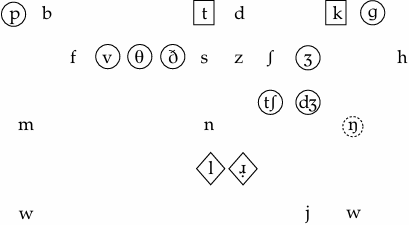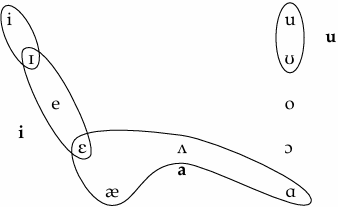
Arabic–English
 المؤلف:
Mehmet Yavas̡
المؤلف:
Mehmet Yavas̡
 المصدر:
Applied English Phonology
المصدر:
Applied English Phonology
 الجزء والصفحة:
P196-C8
الجزء والصفحة:
P196-C8
 2025-03-18
2025-03-18
 721
721
Arabic–English
The overlay of the Arabic consonantal phonemes onto the target English inventory reveals the following:

Other Arabic consonants are /x, ɣ, ħ, ʕ/ and the pharyngealized (emphatic) consonants /tʕ, dʕ, sʕ, lʕ, ʕʕ/.
Missing target phonemes /p, g, v, θ, ð, Ʒ, tʃ, (ʤ)/ are responsible for the following phonemic clashes:

The occurrence of /θ/ and /ð/ in classical Arabic complicates the problem, giving the impression that the learner should not have problems with these targets in English, because she or he has been exposed to these sounds in the study of Arabic. This, however, does not translate into reality and learners have serious problems with respect to English interdentals.
The sound /ʤ/, although present in some dialects of Arabic, was lost in Egyptian Arabic; also noteworthy is the questionable status of /Ʒ/.
The case of /ŋ/ is similar to those of Turkish and Greek, in that this sound occurs as an allophone of /n/ before a velar stop, but cannot stand alone. Thus, while finger [fɪŋgɚ] may not be problematic, because [ŋ] is followed by a velar stop, sing [sɪŋ] and singer [sɪŋɚ] will be (i.e. the expected productions are [sɪŋg] and [sɪŋgɚ]).
The two voiceless stops of Arabic /t, k/ are unaspirated and are expected to be problematic.
Salient phonetic differences are related to liquids once again. The Arabic lateral is ‘clear’, and the r-sound is an alveolar apical trill. In addition, both liquids of Arabic have voiceless allophones pre-pausally following voiceless obstruents. All these result in obvious foreign accents in their English productions. Slight phonetic differences are observed in /t, d/ because they are dental in Arabic.
Mismatches and the resulting insufficient separation of English vowel contrasts are depicted in the following:

Arabic syllable structure, (C) V (C) (C), clashes considerably with that of English. Having no onset clusters and allowing only very limited double codas result in an epenthetic vowel to break up complex English targets.
Although Arabic is a stress-timed language, vowel reductions do not follow English patterns, and this results in some differences in rhythm.
Word stress is fairly regular in Arabic; it falls on the final heavy syllable (one with either a long vowel or a VCC rhyme) of a morpheme. This is responsible for the commonly observed errors (stress on the final syllable as opposed to the native English pattern of initial stress) in difficult, expert, narrowest, institute, where the first three words have VCC rhymes, and the last word has a long vowel in the final syllable.
The following is a summary of the major trouble spots:
• missing target phonemes: /p, g, v, θ, ð, Ʒ, ʧ, (ʤ), (ŋ)/;
• aspiration;
• salient phonetic differences: liquids;
• insufficient separation of several target vowel contrasts;
• onset and coda clusters;
• stress;
• rhythm.
 الاكثر قراءة في Phonology
الاكثر قراءة في Phonology
 اخر الاخبار
اخر الاخبار
اخبار العتبة العباسية المقدسة


